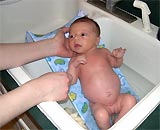Bathing a baby may seem simple, but it can cause anxiety for some parents. Common difficulties include the baby’s small and slippery body; water and soap can accidentally get into the baby’s nose and ears; and during the initial months, the baby cannot maintain balance…
 |
|
(Photo: VNE) |
Here are some tips to ensure the safest bathing experience for your baby:
First, prepare all the necessary “bathing tools”: 2 basins, a dry towel for drying, various types of soap, a bath sponge or soft cloth for scrubbing, clothes, and warm water.
It is very unsafe to leave the baby alone in the bathtub, especially if the baby has just started to walk. If you forget to prepare something, or if someone knocks at the door or your phone rings while bathing the baby, you must take the baby out of the tub, wrap them in a dry towel, and carry them with you.
How to mix the bath water: Fill the tub with cold water first, then gradually add hot water. This method prevents burns for both the person mixing the water and the baby. Test the water temperature with your elbow (as your hands can tolerate high temperatures, which may not be suitable for the baby’s delicate skin). Remember to mix the water before bringing the baby near the bathing area.
Bathing steps: Use a clean, soft, damp cloth to wash the baby’s face and clean their ears and nose first. Then, undress the baby. Dip the baby’s feet into the (soapy) water first; support the baby’s head and armpits with one hand while using the other hand to pour water over the rest of the baby’s body.
Once the baby’s body has acclimated to the water, you can let the baby sit fully in the tub, using one hand to support the armpits and back while the other hand scrubs different parts of the baby’s body, or allow the baby to splash a bit.
Transfer the baby to a clean basin of water, and use a soft cloth to wipe down all parts of the body to rinse off the soap. Then, lift the baby out of the water, dry them with a soft, dry towel, and dress them.
You can use baby soap for bathing, but it is not necessary for newborns. It is advisable to use a baby tub instead of bathing them in an adult bathtub, as a baby tub is easier to move to a draft-free spot in the house. Additionally, bathing in an adult tub wastes water since babies do not require a large amount. Remember to clean the baby tub daily.
If the baby has a lot of hair, be cautious when washing their hair, especially with soap, as soap can get into the baby’s eyes. It is best to wash the hair separately or before bathing. To wash the hair: hold the baby on their back, supporting the neck with one hand while using the other hand to lather soap, then use a bath sponge soaked in water to rinse the soap off gently, being careful around the baby’s eyes and ears.
For newborns, during the first week, they do not need to be bathed every day; a simple wipe-down is sufficient (see below). After that, it is recommended to bathe them once a day at a consistent time to help the baby get accustomed to a biological rhythm, distinguishing between day and night.
Wiping instead of bathing: You will need 2 small soft towels, 1 larger soft towel for drying, 1 warm water bottle, diapers, clean clothes, and 2 clean small basins. Fill one basin with warm water and soak one towel in it. Undress the baby first (keeping the diaper on). Use the damp towel to wipe the baby’s face, neck, and ears. Re-soak the towel and wipe the hands, armpits, and back. Take the dry, soft towel to wrap the cleaned areas. Fill the other basin with warm water, remove the diaper to clean the baby’s bottom and genital area by rinsing in the basin with the remaining small towel. Afterward, dry the baby, and put on a new shirt and diaper.
















































